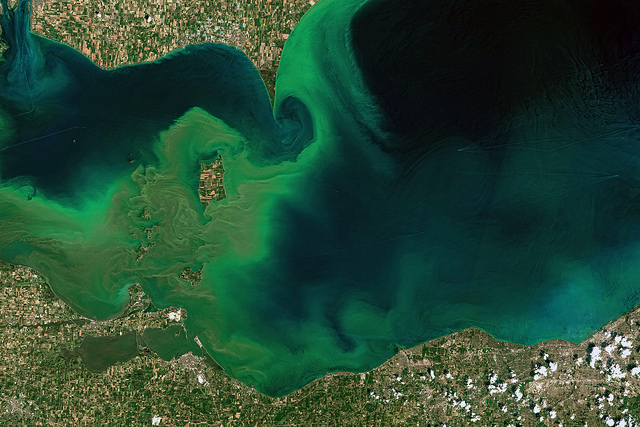英國約克大學生物學家莎瑪(Sapna Sharma)發表新研究指出,氣候變遷造成全球湖泊快速暖化,速度甚至比大氣和海洋還快。
北美大湖之一的伊利湖,優養化現象嚴重。圖片來源:sjrankin(CC BY-NC 2.0)。
世界湖泊平均每十年暖化0.34°C
這項研究蒐集了236個湖泊過去25年來的年度溫度資料。「雖然全球湖泊數量遠多於此,但這236個湖泊包含了全球超過半數的淡水水源。」莎瑪解釋。
此外,這項研究也是首次結合數千位科學家歷時半世紀人工蒐集的湖泊量測資料,以及美國太空總署(NASA)25年來的衛星湖泊溫度資料,據稱是該領域規模最大的研究。
「我們發現全世界湖泊以平均每10年0.34°C的速度暖化,威脅淡水供應和生態系統,可能大幅影響飲用水的供給以及魚類和其他水生動物的棲息。」莎瑪說。
莎瑪指出,從研究結果可以發現,瞭解氣候變遷對全球淡水的衝擊和對全球糧食與淡水供應的影響相當重要。
「我們發現冰封的湖泊,包括加拿大的湖泊,暖化速度是大氣的兩倍,其中北美大湖(Great Lakes)暖化速度全球最快。」莎瑪說。
優養化程度加劇 威脅湖泊生態
研究預測,照目前的暖化速度,接下來百年間湖泊優養化程度將增加20%,減少水中含氧量。優養化可能導致魚群死亡,甚至影響休憩和民生使用的安全性。2014年西班牙托萊多市、美國俄亥俄州和密西根東南部都曾發生過類似的案例。
約克大學科學家警告,對魚類和人類有毒的優養化現象會增加5%,這顯示溫室效應比二氧化碳強25倍的甲烷,將在10年內增加4%。
這項研究由約克大學、加拿大自然科學和工程研究理事會、NASA和美國國家科學基金會資助,發表於《地球物理研究快報》。
2015年四月,NASA和多個研究夥伴宣布合作開發淡水有害優養化早期預警系統,預期能讓海洋水色衛星影像技術更廣泛運用於環境和水質監控。
Climate change has led to warming of lakes at a rapid rate, even faster than the air or the oceans, says York University biologist Sapna Sharma, lead author of a new global study.
In total, 236 lakes were monitored annually for the past 25 years. “While that’s a fraction of the world’s lakes, they contain more than half the world’s freshwater supply,” explained Sharma.
Said to be the largest study of its kind, it is also the first to combine manual lake measurements made by thousands of scientists over more than a century with satellite measurements of lake temperatures collected by NASA over 25 years.
“We found that lakes are warming at an average of 0.34 degrees Celsius each decade all around the world, threatening freshwater supplies and ecosystems,” Professor Sharma said. “This can have profound effects on drinking water and the habitat of fish and other animals.”
The study predicts that at the current rate, algal blooms, which rob water of oxygen, will increase 20 percent in lakes over the next century.
Harmful algal blooms can lead to fish kills. They also can affect the safety of water for recreation and for consumption, as was the case in Toledo, Ohio, and southeast Michigan during a 2014 bloom.
Algal blooms that are toxic to fish and animals would increase by five percent, warn the scientists on the York University lake study.
These rates also imply that emissions of methane, a greenhouse gas that is 25 times more powerful than carbon dioxide, will increase four percent over the next decade.
“We found that ice-covered lakes, including Canadian lakes, are warming twice as fast as air temperatures and the North American Great Lakes are among the fastest warming lakes in the world,” said Sharma.
Sharma says the study demonstrates the importance of assessing the impact of climate in global freshwaters, to evaluate the sustainability of global supplies of food and freshwater.
The study, “Rapid and highly variable warming of lake surface waters around the globe,” was funded by York University, the Natural Sciences and Engineering Research Council of Canada, the U.S. National Atmospheric and Space Administration, NASA, and the U.S. National Science Foundation. It is published in the journal Geophysical Research Letters.
In April 2015, NASA and several partners announced a new multi-agency effort to develop an early warning indicator for harmful algal blooms in fresh water. The system is expected to make ocean color satellite imagery more easily available to environmental and water quality managers.
※ 全文及圖片詳見:ENS







